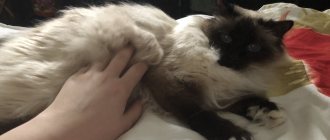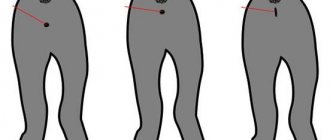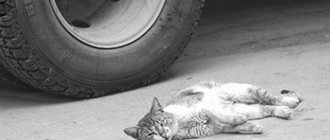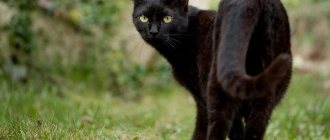When a pet appears in the house, and even one as cute as a cat, it becomes more comfortable and warm, cozy. Why does a furry pet need its own personal hole, since it has all the space in the apartment at its disposal? Fluffy feels comfortable on your pillow or in your bed, on an armchair or even in your closet. But this cannot replace a personal home for a pet.
And besides, a beautiful, homemade cat house knitted, crocheted or made from any other materials will be an effective addition to the interior, giving it special charm and harmony.
Maybe buy a cat house? Online stores and specialized boutiques offer a wide range of cozy, comfortable homes for pets. But making a cat house with your own hands has its advantages.
Firstly, it is economical. To knit an aesthetic product, you will need yarn, knitting needles or a hook, a pattern and a little imagination. Secondly, it will fully match the size of your pet and will fit beautifully into the interior of the room.
Which yarn to choose: pros and cons of each type
For a cat to like its new home, it must be comfortable for the pet. Much depends on the material. You need to choose yarn based on the needs of the animal, not the owner.
Wool
Wool is a good option for a winter home. It retains heat well and does not allow moisture to pass through. The woolen house will not lose its shape after several washes, and cat claws will not ruin it immediately.
Among the disadvantages: pellets may form on the product, and if the yarn is of low quality, then the cat’s home will turn out to be prickly. The first problem can be solved by careful care and dry cleaning, the second by choosing high-quality material. There are allergies to wool - not only in people, but also in cats; this fact cannot always be identified in advance.
Acrylic
Acrylic is cheaper than wool, and there are practically no allergies to it in either people or cats. It is durable, the resulting products are easy to care for, and a variety of colors will help make the cat’s house a stylish piece of art.
But there are disadvantages - acrylic does not allow air and moisture to pass through well. If the acrylic house is not washed often enough, the cat's hair may begin to fall out. To solve this problem, you need to use additional bedding inside the product. Another trouble is static. It is unlikely that a cat will want to climb into a house where discharges crackle from every movement. The animal may find the smell of antistatic agent too strong.
Viscose
Viscose allows moisture to pass through well, does not electrify, is available in a variety of colors, and retains heat. She is very soft. But this type of yarn is not without its drawbacks - viscose is demanding to care for, and if washed incorrectly, it quickly loses its appearance and shape.
To combine the advantages and compensate for the disadvantages of each type, combined threads are used - wool/viscose or acrylic/viscose.
How to knit a house for a cat - 5 master classes:
1. Standard round cat house
In many homes, cats live on their own - they sleep where they want, relax where they like. At the same time, unfortunately, furniture and furnishings are often damaged. The owners believe that this is just a cat’s character, and do not bother with other issues. Or maybe it's worth it? A cat house, of course, does not always solve this problem, but sometimes it really helps.
Cave house
If you think that a cat house should bring pleasure not only to its owner, but also to you, if the aesthetic and ideological content of the work play an important role for you in choosing a project, be sure to pay attention to this “building” - it really is curious, interesting and original.
House for a cat made from leftover yarn
If you haven’t fully decided whether your cat needs a house, and therefore don’t want to spend a lot of money on it, try knitting a temporary “removable” home from leftover yarn. When you are sure that this is a necessary thing, take the temporary cat house out into the yard for those who are unlucky enough to become barn cats, and crochet a new house for your pet.
Cave house
For one reason or another (personal dislike of the cat, incompatibility in size, interior requirements, physical capabilities of the apartment), a standard cat house of a classic shape may not be suitable. The solution is simple - you can knit a cat house in the form of a cocoon - it will be no less cozy and beautiful, warm and comfortable.
House for a cat like a “big fish”
Well, yes, a shark is not a fish at all, that’s understandable. In addition, it is obvious that your cat is unlikely to appreciate your sense of humor and appreciate the fact that you have knitted her a house in the form of such a large one. production, well, okay. Do you understand? And you know? And do you evaluate it? Do you like it, want to smile and be happy? It's enough. Knit!
Which knitting method is suitable
The most convenient way to crochet a house is to get the desired shape easier. But if the housewife likes to knit, this is also doable.
Short Crochet
The main technique that is suitable for a cat house is short crochet. The loops and posts are successively strung on top of each other, gradually creating the product. It takes patience and perseverance, but the results are worth it.
Tunisian knitting
Tunisian knitting is suitable if you need to make a large house for a Maine Coon or a cat that likes to stretch out its paws in its sleep. A long hook is used, on which loops are cast on, like on a knitting needle.
Circular knitting
Circular knitting is suitable for quickly making beds with low sides. The fabric is supported by four knitting needles, the fifth is used as a working knitting needle. The method is not suitable for complex structures.
Instructions for crocheting a cave house
In order to make a cat house, you will need:
- two hooks (No. 8 and 10);
- tapestry needle;
- stitch markers (you can work without them, but it’s inconvenient).
Dimensions of the finished product: diameter of the bottom and roof - 38 cm, height of the walls - 18 cm. It will require 400g of acrylic/viscose. The main method of knitting is double crochet and single crochet.
Making the bottom
The bottom determines the size of the finished cat house. For knitting you will need a No. 8 hook. Process steps:
- Knit 4 air loops, close into a ring.
- The first ring is 3 chain stitches, then 11 double crochets, the last stitch is connecting to the first loop.
- The second ring also starts with 3 chain loops, then alternating - 1 double crochet in the last loop of the previous ring, then double crochet in each loop of the row (24 in total).
- Each subsequent ring begins with 3 air loops. They are followed by double crochets, their number increases by 12. The last stitch is the connecting stitch with the last of the loops. There are 96 columns in the eighth circular row.
- The ninth row ends with a connection not with the last, but with the first loop of 3 air loops at the beginning of the row.
This creates a round base for the house. The mating density will not be too tight, but this is normal - the cat will not have to sleep in this house on the street.
Side walls
To continue, you need to replace the hook and take a second thread. In order for the walls of the house to acquire a vertical shape, the number of columns must be constantly reduced. The beginning of a new stage of work should be marked with a marker - this will make it more convenient to work. Now you need to use single crochets. Sequencing:
- In the first circular row, every fifth column is connected to 2 loops. There are 90 of them in total.
- The next two rows repeat the first, only without decreasing.
- The fourth row, which is also the first for the entrance, begins with an air loop, then 79 single crochets are knitted.
- The knitting needs to be turned over and the previous row repeated in the opposite direction. There are 8 such rows in total.
- In the ninth row, one additional column appears - at the beginning and at the end (82 columns).
- At 10–84 stitches, it repeats the previous row.
- The next row is 6 chain stitches, the last one is connected to the loop on the other side of the hole. Then repeat the base of the wall - 90 single crochets.
This creates a round wall with an opening for entry.
Completion - roof
The end of the walls and the beginning of the roof should be marked with a marker. Then the second thread is disconnected, leaving only the first, the hook must be changed again. As for the bottom, double crochets are used. Sequence of work:
- Three chain stitches, 90 double crochets, the last one connecting with the third loop from the beginning of the row.
- Three chain stitches, then double crochets. Every tenth time two loops are knitted (80 stitches).
- Then each row the number of columns is reduced by 10.
- The last row is to knit two loops together and make a connecting stitch.
The remaining thread needs to be cut, leave a long piece, and use it to tighten the loops so that the product becomes evenly tight. The entrance must be tied with the same thread, using a “crawfish step”. If desired, the finished house can be decorated with decorative details.
DIY cat house: how to make it
The threads for work are taken as natural as possible so as not to cause allergic reactions. At the same time, they are dense and wear-resistant so that they retain their appearance after cleaning, washing and scratching. Average consumption is about 500 g of knitted yarn, wool or acrylic/viscose. The product is created whole or in such parts as:
Return to contents
Cave house
It is a cone-shaped cocoon with an entrance on a wire frame, the circumference of which depends on the size of the animal. Use a thick thread, a hook 8-12 mm thick. They tie the hoop with loops, close the ring and knit using the double-sided fabric technique in a circle, decreasing by 3 loops every 2-3 rows until the required size of the house is reached. The end of the cave can be sewn shut or left open. When using knitting needles, a trapezoidal fabric is created with any elastic band, from which a cone is then formed and joined along the seam. A wire is inserted into a wide socket.
How to tie a needle?
A dome-shaped pouch with an entrance hole in the side wall, similar to an Eskimo dwelling. To create, you need hook number 8, knitting yarn 1 kg. Legend: ch - air loop, sc - single crochet. The beginning and end of the row are united by a connecting column. The height of the finished product is 20 cm, the diameter along the bottom is 37 cm. The technique is as follows:
To make a dome-shaped product, you need to purchase one kilogram of knitting yarn.
- Cast on 3 ch and close into a ring. There will be 41 rows in total.
- In the first three, increase in each, after 1 and 2 loops, respectively.
- 4-18 alternate rows consisting only of sc with increasing rows (every 2 sc - in 5,7, 9 and 11; after 4 - in 13; 5 - in 17).
- at 19-25 the entrance to the house is made. The first method: breaking the thread and skipping 10 loops, the left tail is woven into subsequent rows, forming a beautifully highlighted entrance arch. Second option: the entire row of sc, leave the last 10 loops, turn the work around and knit in the opposite direction from the wrong side.
- 26 all without extra charge, 8 chains are typed above the entrance.
- 27-41 rows of sc alternate with decreasing rows (every 4 sc - in 31, every 3-34, 36, 37, every 2-38, 39, every 1 sc - in 40 and 41) until the circle closes.
If knitting is limited to 20 rows, then the cat will get a nice bed instead of a closed house.
Types of knitted houses with photos
There are many types of pet housing. The main distinguishing parameter is the shape of the house. The photo shows the most common options:
- Round knitted house (nest);
- House-bed;
- Pipe house;
- Soft Cave House;
- Bed with low sides.











